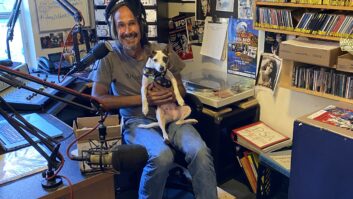The author is membership program director of the National Federation of Community Broadcasters. NFCB commentaries are featured regularly at www.radioworld.com.
This week, Podcast Movement brought out throngs to Philadelphia to learn more about podcasting. As you can see following the #PM18 hashtag on social media, the conference sees tons of parties, sessions and business cards. And though we may be reaching peak-podcast for podcasting about general subjects, there is no shortage of interesting locally focused podcasts produced by community radio.
The popular thinking is that community media has been slow to the podcasting trend. Largely, that’s fair. Only about 40% of stations are podcasting now, a recent survey by the National Federation of Community Broadcasters revealed. However, this Podcast Movement 2018 week is a reminder to community media that podcasts from your own backyard is possible, and sustainable.
[Read: Community Broadcaster — Radio’s Smart Audio Moment]
Four podcasts in particular stand out at the moment as instances where community radio stations could take notes and adapt their own ideas. They include:
WTIP’s Boundary Waters Podcast is a program about, as you might have guessed, the Boundary Waters Canoe Area Wilderness federally designated land located in the northern third of the Superior National Forest, all the way up in northeastern Minnesota. There are more than 2,000 campsites and 1,200 miles of canoe routes in this remote region. Those who have been there know the Boundary Waters features stunning views and formidable terrain for the inexperienced. That stretch of territory represents a lot to get lost in, but also, tons of experiences. The rural Minnesota station says the podcast is “a place to hear stories from the people who visit this amazing outdoor playground.” The podcast also serves as a superlative instructional for city people like me who know nothing about gear, camping and being any longer than two hours in the forest. Listen to episodes here.
“Let’s Talk New Mexico” from KUNM is a call-in show that feeds to podcast. Several programs use this method — most notable in community radio is KALW’s “Your Call” — but this one had to change it up a bit to make it work. Today, where “Let’s Talk New Mexico” excels and keeps it fresh beyond the live radio part is in content. State education, housing, local politics and more are on the docket for the radio program. Producers say they focus on “bringing you the voices of New Mexicans in discussions of our most pressing issues and challenges, and to share advancements and artistic achievements.” Always in the state and never fluff, the program is what good local radio and podcasting should be. Hear the latest and subscribe to upcoming episodes here.
“Madison in the Sixties” is an innovative podcast produced at longtime community radio station WORT, looking back at the history of its city. Podcasts like this are exhilarating for a few reasons. First, for new residents, you can a glimpse at what your new home has been through. For longtime citizens of a city, a podcast on its history takes you down memory lane. And finally, local history podcasts allow stations to tap into their vast wealth of locals who lived through the many diverse experiences of a community. “Madison in the Sixties” is rich in anecdotes and evocative storytelling. Though its more recent focus on local protests might be a little obscure for some listeners, there are many smart ideas for looking at your town’s arts, music, commerce and culture that you might be able to apply wherever you are. You can hear past episodes here.
“Feeding Tompkins” by WRFI(LP). If your station cannot commit to regular podcast, have you considered a multipart podcast instead? Take a look at how WRFI has created these kinds of community media moments for residents. The New York state community radio station has done some excellent programming shared to terrestrial and digital, including a housing series I profiled at The Progressive magazine. This short-run podcast examines the matter of food insecurity in its home area of Tompkins County. Talking with local nonprofits, digging into data and sharing the lives of those without enough to eat are all part of this touching and, at turns, upsetting investigation into how one county contends with hunger among kids, seniors and adults. “Feeding Tompkins” is a collaboration between many local journalists and WRFI and a good example of how community radio can utilize partnerships to provide relevant and engaging programming to audiences. Listen to the eight-part series here.
As I’ve written in Radio World (and exchanged on Twitter with Podcast Movement organizers), my concern with podcasting is always about sustainability and equity. Podcasting can be a world where everyone is trying to be the next big brand, rather than looking at an approach serving communities. In this climate, a local podcast based in community radio represents one of the rare opportunities to craft an identity and an engaged audience. Many of the stations I noted are doing just that. They show other community radio outlets a path forward.












